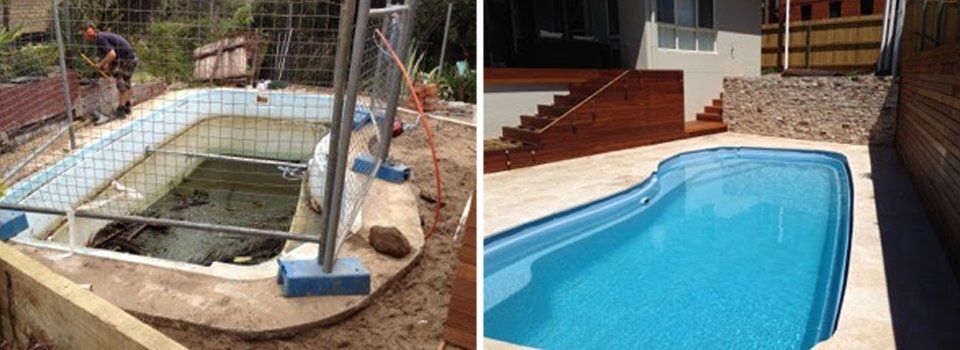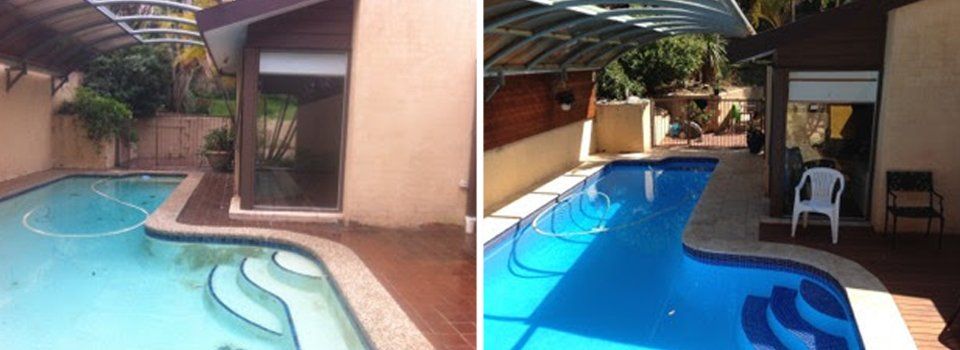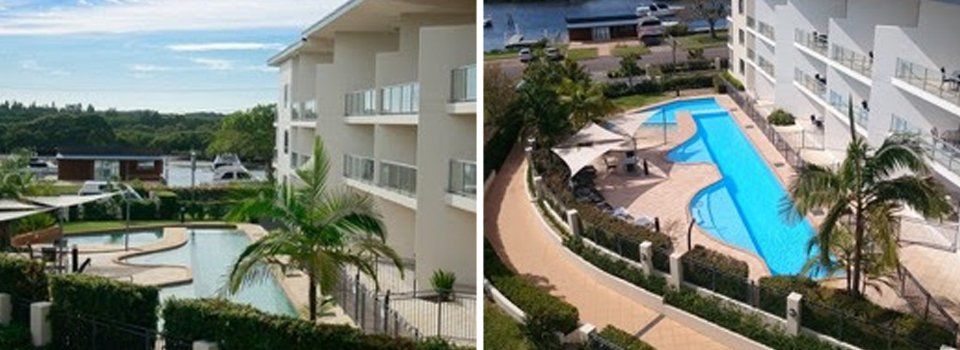Common Pool Issues
Aquaglaze Pool Resurfacing's system of resurfacing has been developed to solve many common pool issues. Below are some examples of the problems solved by resurfacing using our Fibreglass or Epoxy resurfacing (click to enlarge the image). Whether your pool has cracked, is leaking, has osmosis, is discoloured, or the surface is coming away, once Fibreglassed with our Fibreglass system, your pool will be a modern easily maintained centre of your outdoor entertainment.
Pool leaks in general
Losing water is one of most frustrating issue you can have with your pool. Here are a couple of tips on how to find out if you have a leak and how to find it. click here to find leak in your pool
Pebblecrete
Cracked Pebblecrete is successfully repaired by resurfacing with Fibreglass. Once Pebblecrete pools are Fibreglassed they are transformed to a smooth algae resistant modern surface which not only save on chemicals but is non abrasive to the skin.
Pool leaks - tips and advice
Firstly you will need to ascertain whether your water loss is due to evaporation or a leak. The best way of doing this is to do the bucket test.
- Get a bucket (preferably plastic or one that wont rust) that will sit on the step of your pool and sticks out of the water.
- Fill the bucket up to the same water level as your pool.
- Leave it there checking once a day.
- If the pool water level drops lower than the water in the bucket you have a leak or leaks.
- If the water level in the bucket drops at the same rate as your pool you are dealing with water evaporation not a leak.
Pipes or Structure Leak
It pays to check for the more obvious leaks yourself. Look in the filter area for leaks, especially under your pump. If you have a sand filter check the waste line is not leaking. If you suspect the hydrostatic valve at the bottom of the pool is leaking you can sometimes stop or slow the leak by doing the following. Get a bag of sand and place it in several garbage bags, sealing each one well. Then place the bag on the hydrostatic valve – tying a rope to the bag can help to place it by gently dragging it into positionTo determine if the leak is within a pipe or within the pool structure, carry out the evaporation test twice. Once with the system shut off, that is, no filter operating. Then once with the system running for an extended period.
Pool leaks in general
To determine if the leak is within a pipe or within the pool structure, carry out the evaporation test twice. Once with the system shut off, that is, no filter operating. Then once with the system running for an extended period.
You may end up with one of three possible results:
- No difference between tests - Indicates probable structural leak.
- Higher loss with system running - Indicates probable pressure pipe leak.
- No loss with system running Indicates probable suction pipe leak.
If you are still uncertain if there is a leak or where it is, call us on 0434050221 or send an enquiry via our Contact Us page.
If you are dealing with evaporation get a pool cover.
If you have a leak the following procedure will help identify where it is.
- Do not top the pool up. If the water stops dropping when the level gets past the skimmer box your leak is in the reticulation system (pipe work) or the Hydrostatic valve. If your Hydrostatic Valve has not been replaced in the last 5 years get it replaced. If this does not resolve the problem you will need to find and seal the leak in the pipes. The most common leak, other than the Hydrostatic valve, is a separation between the plastic skimmer and the concrete pool. This is easily fixed with some pool putty.
- If the level keeps dropping and stops at the return jets the you have a leak around the jets or you have an upper level crack.
- If the level keeps dropping past the return jets you could have a faulty Hydrostatic valve. It also means you should turn a suspicious eye on the shell of the pool, look for cracks in the plaster or tears in the vinyl. Look closely at the tile line. If you see something that looks like a crack, drop some of your pH indicator test near it with your pump shut off and water still. See if the dye is sucked into the crack. Under water lights can and do leak as well. Especially the conduit that runs from the light niche to the junction box. Filling the opening of the conduit in the back of the light niche with putty or, silicone, is a way to fix this problem.
If you would like any further information to help you with your leaking pool contact us by clicking here.
Repair Process For Pools with a Broken Back
A pool with a broken back
is a pool that has moved excessively and cracked. These cracks cannot be fix by mearly filling them with a filler and coating over them.
Major cracks that may move again need to be treated by a specialist such as Aqualine Pool Resurfacing NSW. The following is an example of a pool that Aqualine repaired.Firstly we grind out the crack producing a 5cm X 5cm channel.Then we produce 5cm X 5cm stitching groves right angled to the main grove.
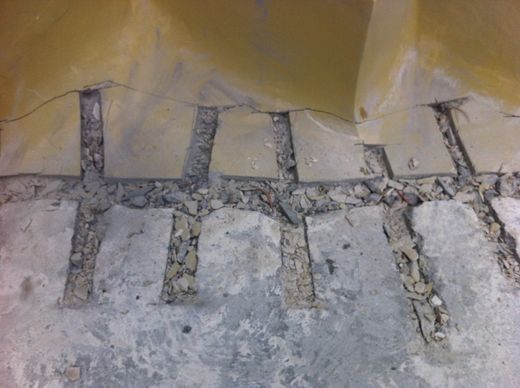
The groves are then coated with a water proofing compound

Then we insert stainless steel rods in the grooves

The Grooves are then filled with concrete and finished of with render, prior to being resurface with the rest of the pool
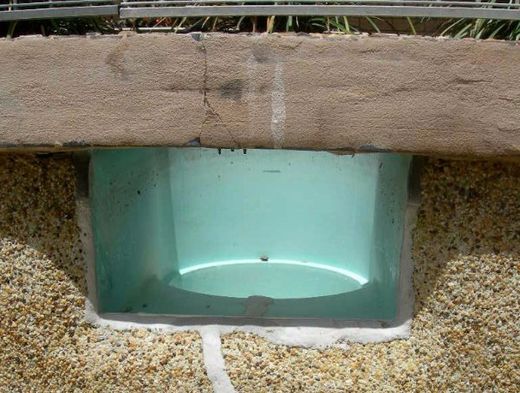
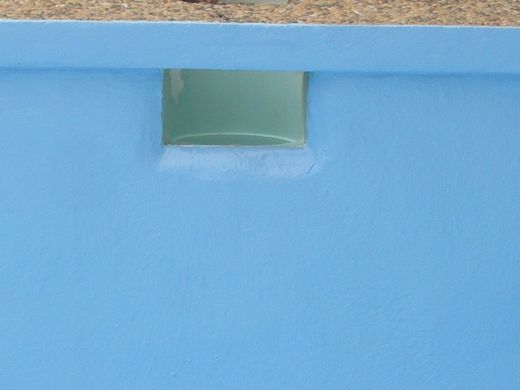
Fibreglass
Fibreglass pools or Spas that are cracked are discoloured and/or have osmosis can be fixed by repairing and resurfacing using a fresh layer of Fibreglass. Once coated with our premium Fibreglass coating you can expect 20-25 years further life from your pool
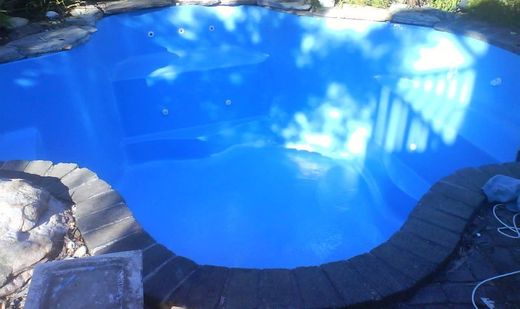
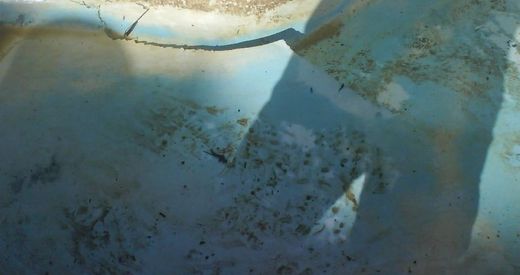
Rust break outs
Rust break outs are easily repaired by treating and resurfacing using Aqualine Pool Resurfacing NSW's Fibreglass system. When the rust spots are treated and coated with our Fibreglass resurfacing they are stopped in there track's never to be seen again.
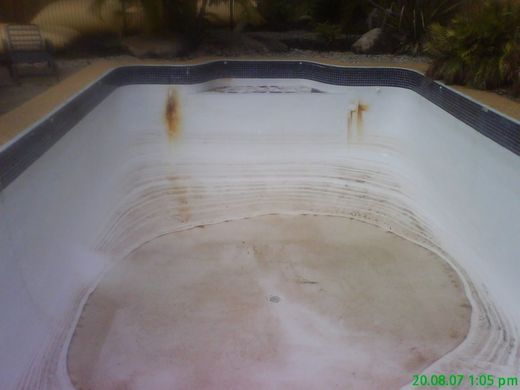
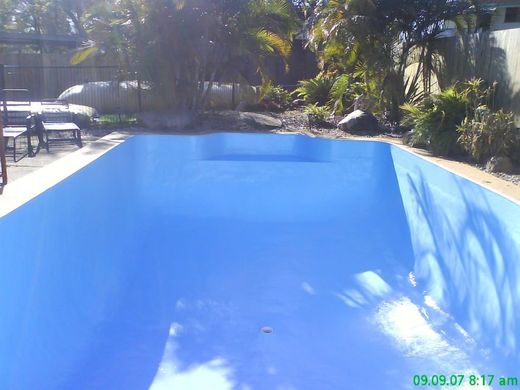
Cracks are filled and then Fibreglass coated. Due to Fibreglass's flexibility and tensile strength, cracks are a thing of the past once coated with Fibreglass.
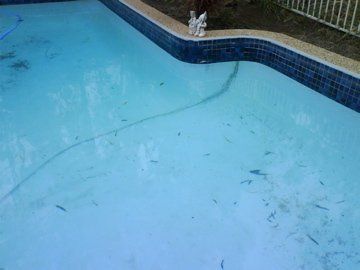
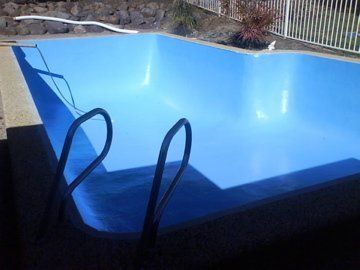
Vinyl liner pools that are deteriorated and damaged can be converted to Fibreglass using Aqualine Pool Resurfacing NSW's Fibreglass system. Never again will you have to worry about resurfacing or re-lining your pool.
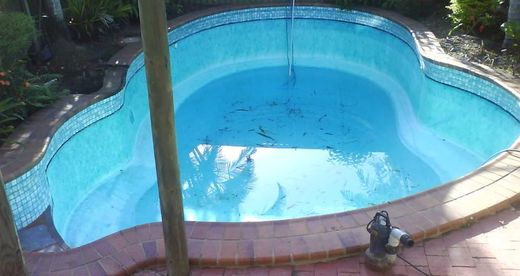
To see more information on Vinyl liner conversions click here
Pools with a broken back are commonly cause by pools being left empty for too long.

Aquaglaze Pool Resurfacing NSW provides you with the most professional, cost effective, pool resurfacing solutions on the market for all your pool problems. This includes fixing leaks, cracks, osmosis, rust, damaged and mouldy pool surfaces. No matter what the original surface of your swimming pool we will be able to apply a suitable surface coating to transform your old worn out pool back to new again. Take a look at our before and afters page to see for yourself the difference a new surface will make.
Click hereIf you require any information on any other problems with your pool or to book a free, no obligation on site quotation or go to our contact page
to leave your details.
Pool tips
Aquaglaze Pool Resurfacing NSW has a mission to make pool ownership as pleasurable as possible. Whether through the application of our easily maintainable Fibreglass coatings or through professional advise and service.
The videos on this page give great advise on various pool issues and general maintenance. Feel free to have a look and if you have any questions contact our friendly staff How to find where air bubbles in your return jets are coming from
Acid wash your pool
Aquaglaze, in Sydney NSW, , offers pool resurfacing, restorations, pool Renovations, and pool coatings, for the Restoration of all types of swimming pools. Aquaglaze Pool Resurfacing
NSW uses the latest, world leading, Aquaglaze pool resurfacing, pool renovation and restoration Fibreglass technology for pool resurfacing. We offer our, market leading, pool resurfacing and renovation, restoration and services in NSW.
Click here for a free quotation Aquaglaze is a licensed and fully insured pool Resurfacing, Renovations, Restoration and coating company providing you with the most professional, cost effective, pool Resurfacing, Renovations and Restoration solutions on the market. The coating we apply resolves many typical pool issue including fixing leaks, cracks, osmosis, rust, damaged mouldy pool surfaces as well as updating and modernising your pools appearance.
Click here for a free quotation Aquaglaze is a licensed and fully insured pool Resurfacing, Renovations, Restoration and coating company providing you with the most professional, cost effective, pool Resurfacing, Renovations and Restoration solutions on the market. The coating we apply resolves many typical pool issue including fixing leaks, cracks, osmosis, rust, damaged mouldy pool surfaces as well as updating and modernising your pools appearance.
No matter what the original surface of your swimming pool we will be able to apply a suitable surface coating that will transform your old worn out pool back to the centre piece of you entertainment area again. Take a look at our before and after picture page to see for yourself the difference a new surface or renovation will make to your pool. click here
Our products are especially designed to handle the unusually harsh Australian conditions. This is why, with our Fibreglass Resurfacing, Renovations or Restorations, Aqualine Pool Resurfacing NSW is confident that you are getting the best, most resilient swimming pool surface on the market. We also back it up with a statutory warranty
You could also join many of our satisfied customers who are enjoying the performance we offer with our Fibreglass pool resurfacing and Epoxy swimming pool painting systems.
To see what many of our customers had to say about our quality and service on our references page or contact us to get a verbal referral click here
So if you're after a new look for your swimming pool and require prompt professional service then leave your full details on our enquiry page click here
and we will give you an estimated price by phone or email on your choice of Resurfacing, Renovations or Restorations.
Also feel free to phone one of our team
for advice on your swimming pool problems and maintenance. We will be happy to assist you with your enquiry.
Basic Pool Chemistry

The following are the basics of pool chemistry. Check out our on line here
FC - Free Chlorine
Free chlorine shows the level of disinfecting chlorine available in the pool chemistry to keep your pool sanitary. FC should be tested and chlorine added daily, unless you have an automatic feeder or SWG, in which case you can test it every couple of days. FC is consumed by sunlight and by breaking down organic material in your pool. The level of FC you need to maintain depends on your CYA level and how much your pool is used. See The Pool Calculator's suggested FC levels section (towards the bottom) or the Chlorine / CYA Chart at TFP's Pool School for guidelines on the appropriate FC level to maintain based on your CYA level. It is important that you do not allow FC to get too low, or you run the risk of getting algae and/or having an unsafe pool.
FC is raised with bleach, liquid chlorine, liquid shock, trichlor tablets/pucks/sticks, dichlor powder, cal-hypo powder/capsules, or lithium hypochlorite. Only use bleach without any additives, typically labeled unscented or "original scent". Trichlor and dichlor also add CYA and lower pH. Cal-hypo also adds calcium. Lithium hypochlorite tends to be quite expensive.
It is most efficient to raise the FC level in the evening, since none will be lost to sunlight until the next morning. FC normally goes down by itself. If you are in a hurry you can lower FC with a chlorine neutralizer (sodium thiosulfate).
CC - Combined Chlorine
Combined chlorine is an intermediate breakdown product that is created in the process of sanitizing the pool. CC causes the "chlorine" smell many people associate with chlorine pools. If CC is above 0.5 you should shock your pool. CC indicates that there is something in the water that the FC is in the process of breaking down. In an outdoor pool, CC will normally stay at or near zero as long as you maintain an appropriate FC level and the pool gets some direct sunlight.
Potassium monopersulfate (a common non-chlorine shock) will often show up on tests as CC. There is a special reagent you can get to neutralize the potassium monopersulfate so you can get a true CC reading.
TC - Total Chlorine
Total chlorine is the sum of FC plus CC. Inexpensive chlorine tests, such as the common OTO test, which shows TC as different shades of yellow, measure TC because it is easier to test for than FC and CC. In normal operation TC can be used as if it was FC because CC is usually zero. However when you have algae or some other problems, CC levels can be significant and TC becomes useless. Return to The Pool Calculator.
pH - Acidity/Alkalinity
pH indicates how acidic or basic the water is. pH should be tested daily at first. Once you gain experience with your pool, less frequent monitoring may be appropriate depending on your pool's typical rate of pH change. pH levels between 7.2 and 7.8 are suitable for swimming, while levels between 7.4 and 7.6 are ideal. pH below 7.2 tends to make eyes sting or burn. pH below 7.0 can cause damage to metal parts, particularly pool heaters with copper heat exchange coils. High pH can lead to calcium scaling. pH contributes to the CSI, which indicates the tendency for plaster damage or calcium scaling. Aeration will tend to cause the pH to rise. This can be mitigated by lowering TA.
Many pools will drift up towards higher pH over time. This is particularly true for fresh plaster (particularly in the first month and continuing for perhaps a year) or when TA is high and the water is being aerated (because of a spa, waterfall, fountain, SWG, rain, kids splashing in the pool, etc).
You can raise pH with borax or soda ash/washing soda. Soda ash/washing soda will increase TA more than borax will. You can lower pH with muriatic acid or dry acid. How much you will need for a given pH change depends on several other numbers, most importantly TA and borate. Higher TA and/or borate levels cause you to need larger amounts of chemicals to change the pH.Return to The Pool Calculator.
TA - Total Alkalinity
Total alkalinity indicates the water's ability to buffer pH changes. Buffering means you need to use a larger quantity of a chemical to change the pH. At low TA levels, the pH tends to swing around wildly. At high TA levels, the pH tends to drift up slowly, or even quickly in extreme cases. TA contributes to the CSI which indicates the tendency for plaster damage or calcium scaling.
The ideal TA level depends on several factors. If you are using acidic chlorine sources, such as trichlor or dichlor, keep TA on the high side, perhaps between 100 and 120. If you have a SWG, or if you commonly run water features such as a spa, waterfall, or fountain, keep TA on the low side, between 60 and 80. Otherwise levels between 70 and 90 are good. Pools with plaster surfaces should factor their CSI into the preferred TA level decision. Pools with vinyl liners can tolerate high TA levels reasonably well.
You can raise TA with baking soda. It is often best to make large TA adjustments in a couple of steps, testing the water after each one, as adding baking soda will also affect the pH and you don't want the pH going out of range. You can lower TA by lowering the pH to between 7.0 and 7.2 with acid and then aerating the water to bring the pH back up. Aeration can be supplied by spa jets, waterfall, fountain, rain, kids splashing, compressed air, or by aiming a return up towards the surface so it breaks the surface of the water and causes bubbles. This process is then repeated until you reach the desired TA.
ATA or CTA - Adjusted or Corrected Total Alkalinity
An adjustment is often made to the measured TA, subtracting out the cyanurate alkalinity, to more closely approximate the alkalinity as CaCO3. The Pool Calculator makes this adjustment automatically when calculating the CSI, so you should enter the unadjusted number directly from the test. Return to The Pool Calculator.
CH - Calcium Hardness
Calcium hardness indicates the amount of calcium in the water. Over time, water with low calcium levels will tend to dissolve calcium out of plaster, pebble, tile, stone, concrete, and to some extent fiberglass surfaces. You can prevent this from happening by keeping the water saturated with calcium. In a vinyl lined pool there is no need for calcium, though high levels can still cause problems. A plaster pool should have CH levels between 250 and 350 if possible. Calcium helps fiberglass pools resist staining and cobalt spotting. If you have a spa you might want to keep CH at at least 100 to 150 to reduce foaming. CH contributes to the CSI which indicates the tendency for plaster damage or calcium scaling.
You increase CH with calcium chloride, sold as a deicer and by pool stores, or calcium chloride dihydrate, sold by pools stores for increasing calcium. You lower calcium by replacing water.
TH - Total Hardness
Total hardness is the sum of calcium hardness and magnesium hardness. Most test strips report TH instead of CH. The ratio of calcium to magnesium varies. As an approximation you can multiply TH by two thirds to get a rough estimate of CH.
Return to The Pool Calculator.
CYA - Cyanuric Acid
Cyanuric acid, often called stabilizer or sometimes conditioner, both protects FC from sunlight and lowers the effective strength of the FC. The higher your CYA level, the more FC you need to get the same effect. It is important to know your CYA level so you can figure out what FC level to aim for. If you don't have a SWG or problems from extremely high amounts of sunlight, CYA is typically kept between 30 and 50. If you have a SWG or very high levels of direct sunlight, CYA is typically kept between 60 and 80. If you are using an ORP controller, keep CYA below 50.
You increase CYA by adding stabilizer. Solid stabilizer can take up to a week to dissolve, so don't retest your CYA level for a week after adding some. You can add stabilizer to the skimmer, in which case you must not backwash or clean the filter for the next week. You can also put stabilizer in a sock and hang the sock near a return. The only practical way to lower CYA is to replace water. Return to The Pool Calculator.
Salt
Salt is required with a SWG. Salt can also be added to the water to enhance the subjective feel of the water. For a SWG, check the manual for the correct salt level for your unit. This level will typically around 3,000, but different models vary. For improved water feel, try levels around 2,000. These levels are less then one tenth of the salt level in ocean water, which has around 35,000 ppm of salt. People vary in their ability to taste low levels of salt. A few people can taste salt levels as low as 1,000, others not until 3,500 or more.
Having salt in the water just slightly increases the risk of corrosion, particularly to surfaces that water splashes onto where the water can evaporate, leaving high concentrations of salt behind. This is normally only a problem for stone work above the water line made from softer kinds of stone. There is a lack of solid information about the salt corrosion risks for many materials, leading to debate about the overall level of risk. Most people with salt in their water do not experience any problems.
Salt can be added using solar salt, sold for use in water softeners (sodium chloride). You want the kind that is 99.4% pure or better and which doesn't have any rust inhibitor or other additives. Crystals are fine. Pellets will work but dissolve slightly more slowly. Pool store salt generally costs more and is more finely ground, but even pellets dissolve quickly enough so that isn't really any advantage. Potassium chloride can be used but you will need 17% more of it and it costs more.
Return to The Pool Calculator.
Borate
Borates can be used to control pH drift due to a SWG or high aeration levels. Borates also help to control algae. Various subjective water quality/feel improvements are also attributed to borates. If you are not intentionally using borates there is no need to test for them. To use borates to control pH rise and algae, add borates to between 30 to 50 ppm.
With borate levels at 30 or above there is a chance that pets which drink the majority of their water from the pool might have some problems. Since pets should always be trained to not drink pool water, this shouldn't be a problem.
You increase borates by adding borax and acid, or by adding boric acid. 20 Mule Team Borax can be found in the laundry detergent section of most large grocery stores. Boric acid is available over the Internet. You lower borates by replacing water. Proteam's Supreme, Bioguard's Optimizer Plus, Omni's Maximizer, and Poolife's Endure all contain borates.
Return to The Pool Calculator.
CSI - Calcite Saturation Index
The calcite saturation index is a tool for estimating the likelihood of plaster corrosion or calcite scaling. The LSI, Langelier Saturation Index, is a very similar but slightly less accurate measure. The CSI uses pH, TA, CH, CYA, temperature, Borate, and Salt levels to estimate the likelihood of problems. A low saturation index means the water is likely to dissolve calcite out of plaster, pebble, tile, stone, and concrete surfaces (and perhaps fiberglass) which will eventually cause damage. A high saturation index means the water is likely to deposit calcite scale on the walls of the pool and in the plumbing.
CSI is most sensitive to changes in pH. With a plaster pool, it is best to try and get your CSI a little below zero, so that changes in pH won't shift your pool too far towards corrosion or scaling. With a vinyl pool the CSI can be kept more negative, which makes it very unlikely that pH changes could get the CSI into the range of scaling risk. Return to The Pool Calculator.
Suggested FC Levels
You need to adjust your FC target level based on your current CYA reading. Higher CYA levels bind up more of the FC, requiring higher FC levels to get the same disinfecting chlorine level. Many people find that a SWG will work with a slightly lower FC level than other forms of chlorine. The normal FC target is given as a range because different pools require different FC levels. If your water starts looking dull or just slightly cloudy try using a higher FC target.
The target FC level is a minimum. You always want the FC level to be at least as high as the target level. FC is commonly lowest in the evening after sunlight has been reducing it all day. If you are adding chlorine once a day in the evening you need to bring the chlorine up to a higher number than this so that your FC level the next evening is at least the target level. How much higher depends on your CYA level, the amount of sunlight that falls on the pool, and how much the pool is used. A CYA of 30 to 50 will generally lose between one half and two thirds of the FC over the course of a sunny day.
Shocking your pool means bringing the FC level up to high levels and holding it there. This will kill anything that might be living in your water and to speed the breakdown of CC. If you have mustard algae you often need to shock at a higher FC level than usual to get rid of the mustard algae. You may also need to move towards the high end of the normal FC range to keep the mustard algae away.
Be careful if your CYA level is really and truly zero. When CYA is really zero you should not bring the FC level above 5. If you have ever used stabilizer or dichlor or trichlor your CYA level won't really be zero. CYA levels up to 15 or 20 can sometimes test as zero. The suggested FC level feature treats a CYA of zero as if it was really one or two. Return to The Pool Calculator.
Suggested Goal Levels
The Pool Calculator can display suggested goal levels from either traditional sources, or from TroubleFreePool.com. Select the source you would like to use and also your primary source of chlorine and pool surface. Suggested goal levels will be displayed for FC, pH, TA, CH, and CYA. Suggested goals are simply a starting point. There are many situations that are not covered by these basic guidelines. Return to The Pool Calculator.
Glossary Bleach - Liquid Chlorine
Common bleach sold in grocery stores is the same thing as liquid chlorine or liquid shock sold by pool stores in some states. You want bleach without any additives, typically labeled unscented or "original scent". Check the strength of the bleach when comparing prices. Bleach with a higher percentages of sodium hypochlorite is more effective and easier to carry.
ORP - Oxidation Reduction Potential
A kind of sensor that reacts to disinfecting chlorine levels which is used in some systems that automatically feed chlorine into the pool based on the sensor's measurement of the current chlorine level in the pool.
Shock - Shocking Your Pool
Shocking your pool means bringing the FC level up to high levels and holding it there. This will kill anything that might be living in your water and to speed the breakdown of CC. The appropriate FC level to aim for depends on your CYA level.
Algae will fight your attempts to bring the FC level up. You need to test the water and bring the FC level back up to shock level at frequently as possible, preferably at least three times a day, in order to get ahead of algae. Hold the water at shock level until the FC does not change overnight and all CC is eliminated.
When fighting algae you also want to brush the entire pool each day. This will expose any algae growing in biofilms on the walls or floor to the chlorine and allow the chlorine to do it's work. If you have black algae it is particularly important that you vigorously brush the algae as frequently as possible.
SWG - Salt Water Chlorine Generator
A system that turns salt in the water into disinfecting chlorine.
Do it yourself Pool Resurfacing
"Can I resurface my own pool? .........Yes You Can and save thousands of dollars... " Aqualine Pool Resurfacing have many teams available across NSW to resurface pools however there are many of our customers who either live too far away, are in other states or who just want to do it themselves - this is where we can assist you with our DIY option to paint your pool.
Click Here if you would like a quotation for an Aqualine do it yourself pool painting Kit
This photo was sent to us by a proud DIY customer
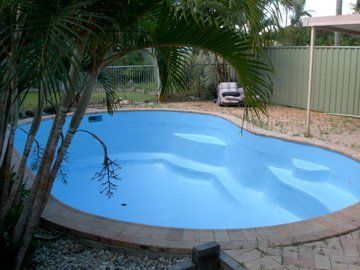
Doing your own pool resurfacing can be an exciting and gratifying experience. Some of the many benefits of doing the project yourself are;
Savings
Successful homeowner - renovators generally have a strong desire to save money. Do-it-yourself pool painting resurfacing will save you several thousand dollars.
Existing Pool Surface
No mater what your existing pool surface, be it concrete, painted concrete, Marblesheen, Pebblecrete, or Fibreglass it is an ideal candidate for painting.
Easy Instructions
Included with your Aqualine Pool Resurfacing DIY kit is an easy to follow instructions. The instructions will walk you through the simple steps and techniques of painting your pool from beginning to end. Additionally Aquaglaze provides phone support on any questions you may have during the resurfacing process.
Satisfaction
If you are willing to invest the time (4-5 days), past customers report immense satisfaction at transforming their old worn out pools. From start to finish your accomplishment will provide you with enjoyment and pride. You can also start and finish the project at your own pace and spend as much or as little time on it as you wish giving you total control over the entire project.
Resurfacing Kits
Aquaglaze will deliver a complete kit to your door. The kit includes all the materials you will need to carry out the entire project. The product you get with the do-it-yourself kit is the same used by our resurfacing technicians. You can achieve the same results by following our simple instructions. All you need to supply is some buckets, rollers and brushes, we will even advise you on the cheapest and best ones to use.
DIY Made Simple
Aquaglaze pioneered the use of DIY pool resurfacing in Australia and have since been welcomed by the DIY market. We supply all the material plus step by step instructions along with unlimited on line and telephone support. Our process and instructions are easy to follow which ensures your project is well done resulting in a beautiful long lasting pool renovation.
For any additional information please contact us by calling 0434050221 or by filling in the Do-It-Yourself Pool Resurfacing Inquiry Form
If you decide you would prefer to use Aquaglaze Pool Resurfacing NSW to resurface your pool please fill in the Enquiry Form for a free quote.
As you browse through this site you will find lots of information on pool resurfacing. See some of our before and after pictures.

